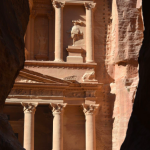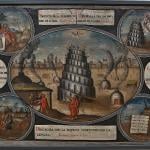MARK 1:40-45
I am so used to thinking of Jesus healing lepers that I really have never given a second thought as to just what leprosy is … except that I knew there is (or used to be?) a leper colony on Hawaii and eventually bits of you would fall off. Here we have the whole agonizing description of the three types of leprosy. It gives me an entirely new appreciation for the unbelievable suffering lepers endured and the fact that Jesus was so unafraid that he would touch the lepers to make them whole.
The fate of the leper was truly hard… Let us look first at the facts.
There are three kinds of leprosy. (i) There is nodular or tubercular leprosy. It begins with an unaccountable lethargy and pains in the joints. Then there appear on the body, especially on the back, symmetrical discolored patches. On them little nodules form, at first pink, then turning brown. The skin is thickened. The nodules gather specially in the folds of the cheek, the nose, the lips and the forehead. The whole appearance of the face is changed until the man loses his human appearance and looks, as the ancients said, like a lion or satyr. The nodules grow larger and larger; they ulcerate and from them comes a foul discharge. The eye-brows fall out; the eyes become staring; the voice becomes hoarse and the breath wheezes because of the ulceration of the vocal chords. The hands and the feet also ulcerate. Slowly the sufferer becomes a mass of ulcerated growths. The average course of the disease is nine years, and it ends in mental decay, coma and ultimately death. The sufferer becomes utterly repulsive both to himself and others.
(ii) There is anesthetic leprosy. The initial stages are the same; but the nerve trunks also are affected. The infected area loses all sensation. This may happen without the sufferer knowing that it has happened; and he may not realize that it has happened until he suffers some burning or scalding and finds that there is no feeling whatsoever where pain ought to be. As the disease develops the injury to the nerves causes discolored patches and blisters. The muscles waste away; the tendons contract until the hands become like claws. There ensues chronic ulceration of the feet and of the hands and then the progressive loss of fingers and of toes, until in the end a whole hand or a whole foot may drop off. The duration of the disease is anything from twenty to thirty years. It is a kind of terrible progressive death of the body.
(iii) The third kind of leprosy is a type — the commonest or all — where nodular and anesthetic leprosy are mixed.
The Gospel of Mark
(The Daily Bible Series*, rev. ed.)
Now, let’s think about something else — what did the leper seek? Healing, of course. But there are many sorts of healing as we shall see. Certainly this helped me see the deeper meaning beneath the request and healing.
In approaching Jesus, the leper makes a bold move. Not only does he violate the strictures of the law, but he risks encountering the familiar reaction of horror and revulsion at the sight of a leper. He kneels, a sign of both supplication and reverence (Ps 22:30; 95:6). His plea, If you wish, shows his utter confidence in Jesus’ power. Significantly, he does not ask Jesus to heal him but to make him clean. His deepest desire is to be free once again to partake in the worship of God’s people.
[…]
Jesus tells the cleansed man to show himself to a priest and offer the sacrifice prescribed for cleansing from leprosy (see Lev 14) … The prescribed rite was to take two clean birds, one to be sacrificed and the other, dipped in the blood of the first, to fly away free (Lev 14:3-7). If the man complied with Jesus’ word, he might have discovered a symbolic image foreshadowing Jesus’ own sacrifice and helping him understand more deeply what Jesus had done for him. But for now, he is unable to contain his delight. …











